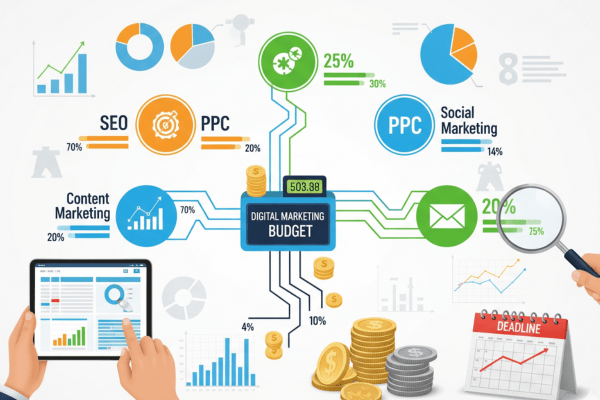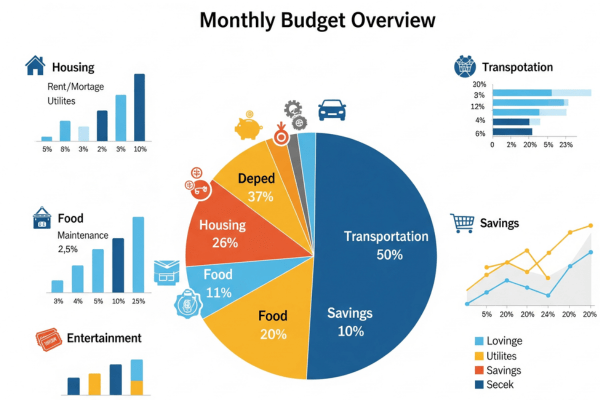Table of Contents

- Introduction
- Why Budgeting Matters (Think of it Like Fuel)
- Step-by-Step: How to Build Your Marketing Budget
- 3.1 Start with Your Goals
- 3.2 Know Your Audience Inside Out
- 3.3 Look at Benchmarks (But Don’t Copy Blindly)
- 3.4 Pick the Right Channels
- 3.5 Spread Out Your Budget (Sample Plan)
- 3.6 Track, Test, Adjust
- 3.1 Start with Your Goals
- Mistakes You Want to Avoid
- Real-Life Example
- FAQs
- Conclusion
1. Introduction
Being an entrepreneur is exciting but also challenging. You’re constantly balancing limited resources, endless tasks, and ambitious goals. One area that often creates confusion is digital marketing spend.
Should you spend more on ads? Or focus on SEO? What percentage of your revenue should go into marketing? And most importantly, how do you make sure you’re not wasting money?
This guide will break it all down for you. By the end, you’ll know exactly how to budget your digital marketing like a pro, even if you’re just starting with a small budget.
2. Why Budgeting Matters (Think of it Like Fuel)

- Too little fuel → the car won’t move.
- The wrong fuel → the engine breaks down.
- The right amount of fuel → smooth journey toward your business goals.
Budgeting gives you:
- Clarity: You know where your money is going.
- Focus: You avoid shiny distractions and spend only where it counts.
- ROI: You actually see returns on every dollar (or rupee) spent.
- Growth: A budget makes scaling predictable instead of random.
In short, budgeting turns guesswork into strategy.
3. Step-by-Step: How to Build Your Marketing Budget
3.1 Start with Your Goals
Every rupee should tie back to a clear goal. Ask yourself:
- Do I want more sales right now?
- Do I need brand visibility first?
- Am I focused on building trust and authority?
👉 Example:
- A local gym may prioritize brand awareness and new sign-ups → invest more in Facebook/Instagram ads.
- A B2B software startup may want high-quality leads → spend more on LinkedIn ads and SEO.
3.2 Know Your Audience Inside Out
Your audience decides your budget distribution. Spend where they spend time.
- Younger audience? Instagram, TikTok, YouTube.
- Professionals? LinkedIn, Twitter, industry blogs.
- Local customers? Google Business Profile, Facebook, WhatsApp marketing.
If you skip this step, you’ll burn money on the wrong platforms.
3.3 Look at Benchmarks (But Don’t Copy Blindly)
Generally, businesses spend 7–10% of revenue on marketing, with 40–50% of that on digital.
But remember—benchmarks are guides, not rules.
- E-commerce often requires higher ad budgets.
- A local bakery can grow with smaller, more targeted campaigns.
3.4 Pick the Right Channels
Not every channel is worth your money. Choose based on goals:
- SEO (Search Engine Optimization): Great for long-term growth.
- Google Ads (PPC): Best for quick conversions.
- Social Media Ads (Meta, TikTok, LinkedIn): Perfect for awareness and targeting.
- Email Marketing: Affordable, builds relationships.
- Content Marketing (blogs, videos, reels): Positions you as an authority.
3.5 Spread Out Your Budget (Sample Plan)

Let’s say your monthly marketing budget is $2,000:
- Social Media Management: 20% ($400)
- Email Marketing: 10% ($200)
- Tools/Analytics: 10% ($200)
This mix balances quick wins (ads) and long-term strategies (SEO/content).
3.6 Track, Test, Adjust
Budgeting is not a “set it and forget it” game.
- Track KPIs: clicks, conversions, ROI.
- Run A/B tests.
- Move money from underperforming campaigns to high-performing ones.
Marketing is a cycle of test → learn → improve.
4. Mistakes You Want to Avoid
- Spending heavily on ads without a funnel.
- Ignoring organic marketing (SEO, content, free social media).
- Copying competitors blindly.
- Trying to be on every platform at once.
- Being inconsistent (spending big one month, nothing the next).
5. Real-Life Example
- Local Café Owner (Small Budget):
- Instagram ads for offers → attract nearby walk-ins.
- Google My Business updates → more local search visibility.
- WhatsApp marketing → remind loyal customers.
- Instagram ads for offers → attract nearby walk-ins.
- E-commerce Entrepreneur (Bigger Budget)
- Google Shopping ads → high-intent buyers.
- SEO for product pages → long-term free traffic.
- Influencer collabs → social proof and brand trust.
- Google Shopping ads → high-intent buyers.
Both spend differently, but both win—because their budgets match their goals.
6. FAQs

Q1. How much should I spend on digital marketing as a startup?
Start with 5–10% of revenue. Focus on low-cost, high-impact methods like SEO, social media, and email before scaling ads.
Q2. Ads vs SEO: which one is better?
Ads give quick results but stop when spending stops. SEO takes time but builds lasting free traffic. Best strategy? Do both in balance.
Q3. What if I have a very small budget?
Leverage free methods—social posts, Google Business, email newsletters, networking. Paid ads should come later.
Q4. How do I know if my budget is working?
Track ROI metrics: cost per lead, return on ad spend, website traffic, and conversions. If results improve steadily, your budget is effective.
Q5. Do I need expensive tools?
Not at first. Start with free tools (Google Analytics, Canva, Mailchimp free plan). Upgrade only when your business grows.
7. Conclusion
Budgeting your digital marketing spend isn’t about spending the most—it’s about spending smart.
- Define your goals.
- Understand your audience.
- Spread your budget wisely.
- Track results and adjust continuously.
- Even a small, well-planned budget can create massive results if used strategically. Don’t fall into the trap of thinking marketing is “too expensive.” In reality, not marketing properly is far more costly.
So, start today. Plan your budget, test what works, and scale step by step. Your business deserves growth, and the right budget is the fuel to get you there.
